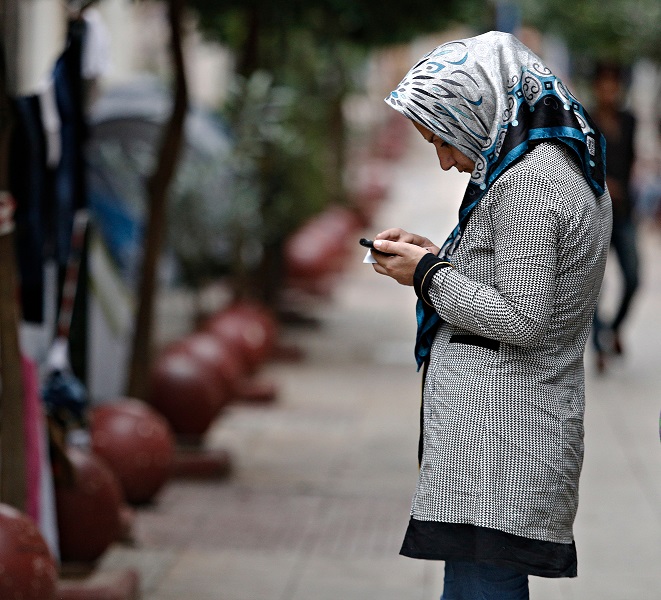How has digital technology changed migrants’ lives?
Over the past few decades, migrants have become increasingly connected, as have societies in both their home and host countries. The use of new technologies allows them to maintain ties with their home countries while helping them integrate in their new countries. They also play an important role in the process of migration itself. Dana Diminescu, a sociologist at Télécom ParisTech, is exploring this link between migration and digital technology and challenging the traditional image of the uprooted migrant. She explains how new uses have changed migratory processes and migrants’ lives.
When did the link between migration and digital technology first appear?
Dana Diminescu: The link really became clear during the migration crisis of 2015. Media coverage highlighted the migrants’ use of smartphones and the public discovered the role telephones play in the migration process. A sort of “technophoria” appeared for refugees. This led to a great number of hackathons being organized to make applications to help immigrants, with varying degrees of success. In reality, the migrants were already connected well before the media hype of 2015. In 2003, I’d already written an epistemological manifesto on the figure of the connected migrant, based on observations dating from the late 1990s.
In 1990, smartphones didn’t exist yet; how were migrants ‘connected’ at that time?
DD: My earliest observation was the use of a mobile phone by a collective of migrants living in a squat. For them, the telephone was a real revolution and an invaluable resource. They used it to develop a network and find contacts. This helped them find jobs and housing, in short, it helped them integrate society. Two years later, those who had been living in the squat had got off the street and the mobile phone played a large role in making this possible.
What has replaced this mobile phone today?
DD: Social media play a very strong role in supporting integration for all migrants, regardless of their home country or cultural capital. One of the first things they do when they get to their country of destination is to use Facebook to find contacts. WhatsApp is also widely used to develop networks. And YouTube helps them learn languages and professional skills.

Dana Diminescu has been studying the link between migrants and new technologies since the late 1990s.
Are digital tools only useful in terms of helping migrants integrate?
DD: No, that’s not all – they also have an immediate, performance-related effect on the migratory process itself. In other words, an individual’s action on social media can lead to almost instantaneous effect on migration movement. A message posted by a migrant showing that he was able to successfully cross the border at a certain place on the Balkan route creates movement. The other migrants will adjust their journey that same day. That’s why we now talk about migration traceability rather than migration movement. Each migrant uses and leaves behind a record of his or her journey. These are the records used in sociology to understand migrants’ choices and actions.
Does the importance of digital technology in migration activity challenge the traditional image of the migrant?
DD: For a long time, humanities research focused on the figure of the uprooted migrant. In this perception of migrants, they are at once absent from their home country, and absent from their destination country since they find it difficult to fit in completely. New technologies have had an impact on this view, because they have made these forms of presence more prominent. Today, migrants can use tools like Skype to see their family and loved ones from afar and instantly. In interviews, migrants tell me, “I don’t have anything to tell them when I go back to see them since I’ve already told them everything on Skype.” As for presence in their destination countries, digital tools play an increasingly important role in access, whether for biometric passports or cards to access work, transport etc. For migrants, the use of these different tools makes their way of life very different to the way it would have been a few years ago, when such access had not yet been digitized. It is now easier for them to exercise their rights.
Does this have an effect on the notion of borders?
DD: Geographical borders don’t have the same meaning they used to. As one migrant explained in his account one day, “They looked for me on the screen, they didn’t find me, I got through.” Borders are now based on our personal data: they’re connected to our date of birth, digital identities, locations. These are the borders migrants have to get around today. That’s why their telephones are confiscated by smugglers so that they can’t be traced, or why they don’t bring their smartphones with them, so that border police won’t be able to force them to open Facebook.
So digital technology can represent a hurdle for migrants?
DD: Since the migrants are connected, they can, of course, be traced. This limiting aspect of digital technology also exists in the uses of new technology in destination countries. Technology has increased the burden of the informal contract between those who leave and those who stay behind. Families expect migrants to be very present. They expect individuals to be available for them at the times they’re used to spending in their company. In interviews, migrants say that it’s a bit like a second job. They don’t want to appear as if they have broken away, they have to check in. At times, this leads to migrants’ lying, saying that they’ve lost their mobile phone or that they don’t have internet access, to free themselves from the burden of this informal contract. In this case, digital technology is seen as a constraint, and at times it can even be highly detrimental to social well-being.
In what sort of situations is this the case?
DD: In refugee camps, we’ve observed practices that cut migrants off from social ties. In Jordan, for example, it’s impossible to send children to get food for their parents. Individuals must identify themselves with a biometric eye scanner and that’s the only way for them to receive their rations. If they can’t send their children, they can’t send their friends or neighbors either. There is a sort of destruction of the social fabric and support networks. Normal community relationships become impossible for these refugees. In a way, these technologies have given rise to new forms of discrimination.
Does this mean we must remain cautious?
DD: We must be wary of digital solutionism. We conducted a research project with Simplon on websites that provide assistance for migrants. A hundred sites were listed. We found that for the most part, the sites were either not usable or not finalized — and when they are, they’re rarely used. Migrants still prefer using social media over specific digital tools. For example, they would still rather learn a language with Google Translate than use a language learning application. They realize that they need certain things to facilitate their learning and integration process. It’s just that the tools that have been developed for these purposes aren’t effective. So we have to be cautious and acknowledge that there are limitations to digital technology. What could we delegate to a machine in the realm of hospitality? How many humans are there behind training programs and personal support organizations?





Trackbacks & Pingbacks
[…] How has digital technology changed migrants’ lives? […]
Leave a Reply
Want to join the discussion?Feel free to contribute!